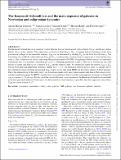The Kennicutt-Schmidt law and the main sequence of galaxies in Newtonian and Milgromian dynamics
Abstract
The Kennicutt-Schmidt law is an empirical relation between the star formation rate surface density (ΣSFR) and the gas surface density (Σgas) in disc galaxies. The relation has a power-law form ΣSFR ∝ Σgasn. Assuming that star formation results from gravitational collapse of the interstellar medium, ΣSFR can be determined by dividing Σgas by the local free-fall time tff. The formulation of tff yields the relation between ΣSFR and Σgas, assuming that a constant fraction (ΣSFE) of gas is converted into stars every tff. This is done here for the first time using Milgromian dynamics (MOND). Using linear stability analysis of a uniformly rotating thin disc, it is possible to determine the size of a collapsing perturbation within it. This lets us evaluate the sizes and masses of clouds (and their tff) as a function of Σgas and the rotation curve. We analytically derive the relation ΣSFR ∝ Σgasn both in Newtonian and Milgromian dynamics, finding that n = 1.4. The difference between the two cases is a change only to the constant pre-factor, resulting in increased ΣSFR of up to 25 per cent using MOND in the central regions of dwarf galaxies. Due to the enhanced role of disc self-gravity, star formation extends out to larger galactocentric radii than in Newtonian gravity, with the clouds being larger. In MOND, a nearly exact representation of the present-day main sequence of galaxies is obtained if ϵSFE = constant ≈ 1.1 per cent. We also show that empirically found correction terms to the Kennicutt-Schmidt law are included in the here presented relations. Furthermore, we determine that if star formation is possible, then the temperature only affects ΣSFR by at most a factor of √2.
Citation
Zonoozi , A H , Lieberz , P , Banik , I , Haghi , H & Kroupa , P 2021 , ' The Kennicutt-Schmidt law and the main sequence of galaxies in Newtonian and Milgromian dynamics ' , Monthly Notices of the Royal Astronomical Society , vol. 506 , no. 4 , pp. 5468-5478 . https://doi.org/10.1093/mnras/stab2068
Publication
Monthly Notices of the Royal Astronomical Society
Status
Peer reviewed
ISSN
0035-8711Type
Journal article
Description
Funding: Supported in part by Fondazione Cassa di Risparmio in Bologna, Project: “Biologia e clinica delle gravi insufficienze d’organo”, year 1999.Collections
Items in the St Andrews Research Repository are protected by copyright, with all rights reserved, unless otherwise indicated.
Related items
Showing items related by title, author, creator and subject.
-
SDSS-IV MaNGA: How the stellar populations of passive central galaxies depend on stellar and halo mass
Oyarzún, Grecco A.; Bundy, Kevin; Westfall, Kyle B.; Tinker, Jeremy L.; Belfiore, Francesco; Argudo-Fernández, Maria; Zheng, Zheng; Conroy, Charlie; Masters, Karen L.; Wake, David; Law, David R.; McDermid, Richard M.; Aragón-Salamanca, Alfonso; Parikh, Taniya; Yan, Renbin; Bershady, Matthew; Sánchez, Sebastián F.; Andrews, Brett H.; Fernández-Trincado, José G.; Lane, Richard R.; Bizyaev, D.; Boardman, Nicholas Fraser; Lacerna, Ivan; Brownstein, J. R.; Drory, Niv; Zhang, Kai (2022-07-06) - Journal articleWe analyze spatially resolved and co-added SDSS-IV MaNGA spectra with signal-to-noise ratio ∼100 from 2200 passive central galaxies (z ∼ 0.05) to understand how central galaxy assembly depends on stellar mass (M*) and halo ... -
Secular-and merger-built bulges in barred galaxies
Mendez Abreu, Jairo; Debattista, V. P.; Corsini, E. M.; Aguerri, J. A. L. (2014-12) - Journal articleContext. Historically, galaxy bulges were thought to be single-component objects at the center of galaxies. However, this picture is now questioned since different bulge types with different formation paths, namely classical ... -
Galaxy And Mass Assembly (GAMA) : galaxy close pairs, mergers and the future fate of stellar mass
Robotham, A. S. G.; Driver, S. P.; Davies, L. J. M.; Hopkins, A. M.; Baldry, I. K.; Agius, N. K.; Bauer, A. E.; Bland-Hawthorn, J.; Brough, S.; Brown, M. J. I.; Cluver, M.; De Propris, R.; Drinkwater, M. J.; Holwerda, B. W.; Kelvin, L. S.; Lara-Lopez, M. A.; Liske, J.; Lopez-Sanchez, A. R.; Loveday, J.; Mahajan, S.; McNaught-Roberts, T.; Moffett, A.; Norberg, P.; Obreschkow, D.; Owers, M. S.; Penny, S. J.; Pimbblet, K.; Prescott, M.; Taylor, E. N.; van Kampen, E.; Wilkins, S. M. (2014-11-11) - Journal articleWe use a highly complete subset of the Galaxy And Mass Assembly II (GAMA-II) redshift sample to fully describe the stellar mass dependence of close pairs and mergers between 10(8) and 10(12)M(circle dot). Using the analytic ...

